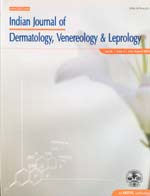
|
Indian Journal of Dermatology, Venereology and Leprology
Medknow Publications on behalf of The Indian Association of Dermatologists, Venereologists and Leprologists (IADVL)
ISSN: 0378-6323
EISSN: 0378-6323
Vol. 71, No. 3, 2005, pp. 179-181
|
 Bioline Code: dv05057
Bioline Code: dv05057
Full paper language: English
Document type: Research Article
Document available free of charge
|
|
|
Indian Journal of Dermatology, Venereology and Leprology, Vol. 71, No. 3, 2005, pp. 179-181
| en |
Studies - Clinical profile of forefoot eczema: A study of 42 cases
Brar Kamal Jeet, Shenoi S.D., Balachandran C., Mehta Vandana Rai
Abstract
BACKGROUND : Forefoot eczema (FE) is characterized by dry fissured dermatitis of the plantar surface of the feet.
AIM : To study the clinical profile of FE and the possible etiological factors.
METHODS : Forty-two patients with FE were included in the study. A detailed history was recorded and examination done. Fungal scrapings and patch test with Indian Standard Series (ISS) were performed in all patients.
RESULTS : The most common site affected was the plantar surface of the great toe in 16 (38.09%) patients. Hand involvement, with fissuring and soreness of the fingertips and palm, was seen in four patients (9.5%). Seven patients (16.6%) had a personal history of atopy whereas family history of atopy was present in six (14.2%). Seven patients (16.6%) reported aggravation of itching with plastic, rubber or leather footwear, and 13 (30.9%), with detergents and prolonged contact with water. Negative fungal scrapings in all patients ruled out a dermatophyte infection. Patch testing with ISS was performed in 19 patients and was positive in five.
CONCLUSIONS : FE is a distinctive dermatosis of the second and third decade, predominantly in females, with a multifactorial etiology, possible factors being chronic irritation, atopy, footwear and seasonal influence.
Keywords
Forefoot eczema, Atopy
|
| |
© Copyright 2005 Indian Journal of Dermatology, Venereology and Leprology.
Alternative site location: http://www.ijdvl.com
|
|
